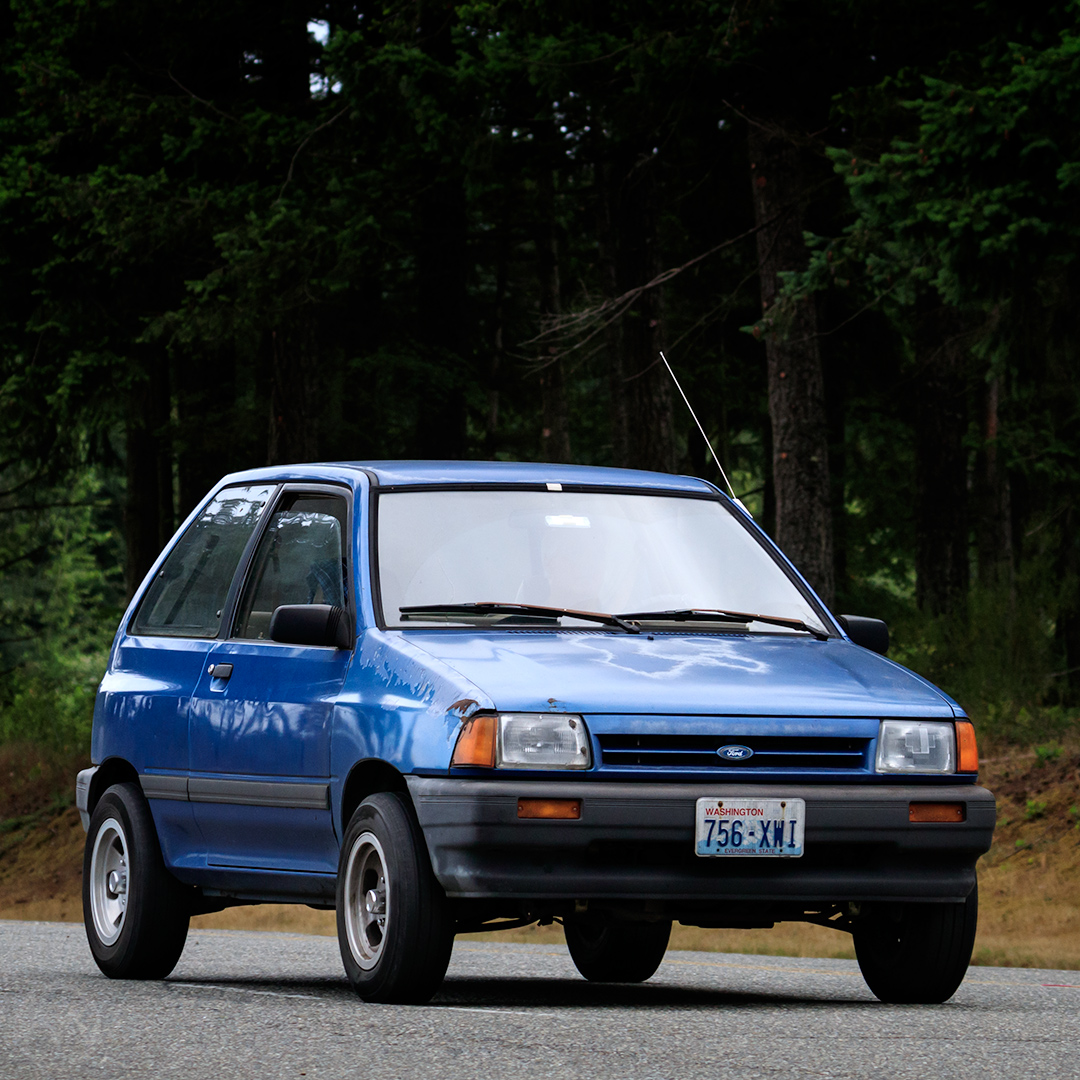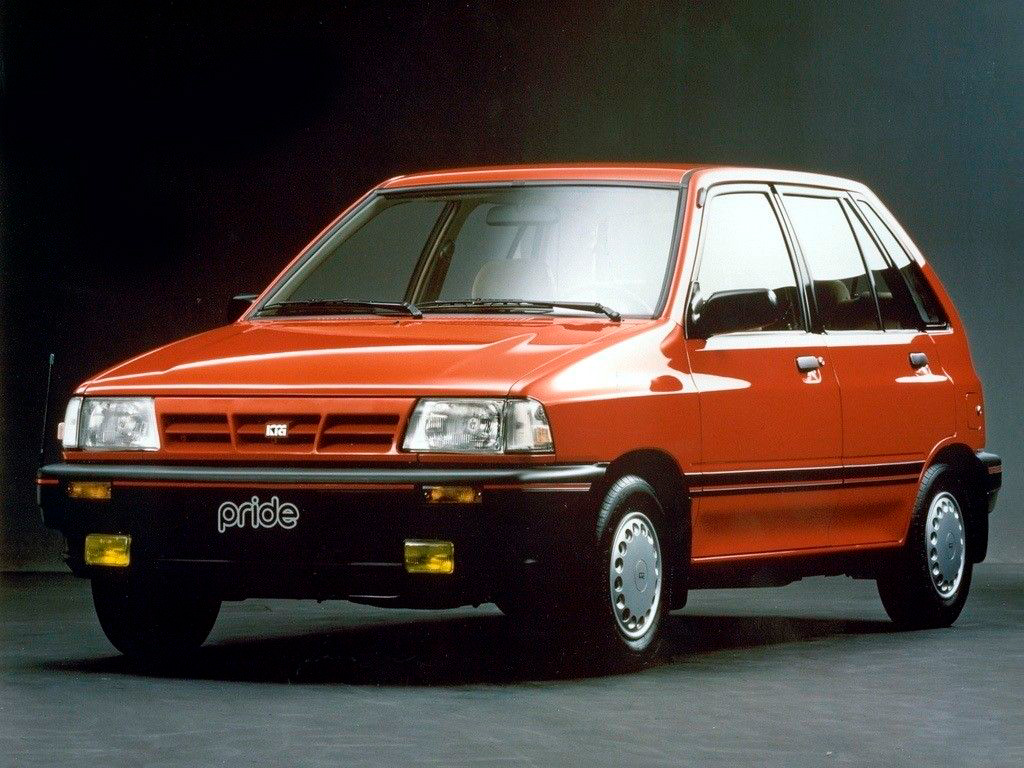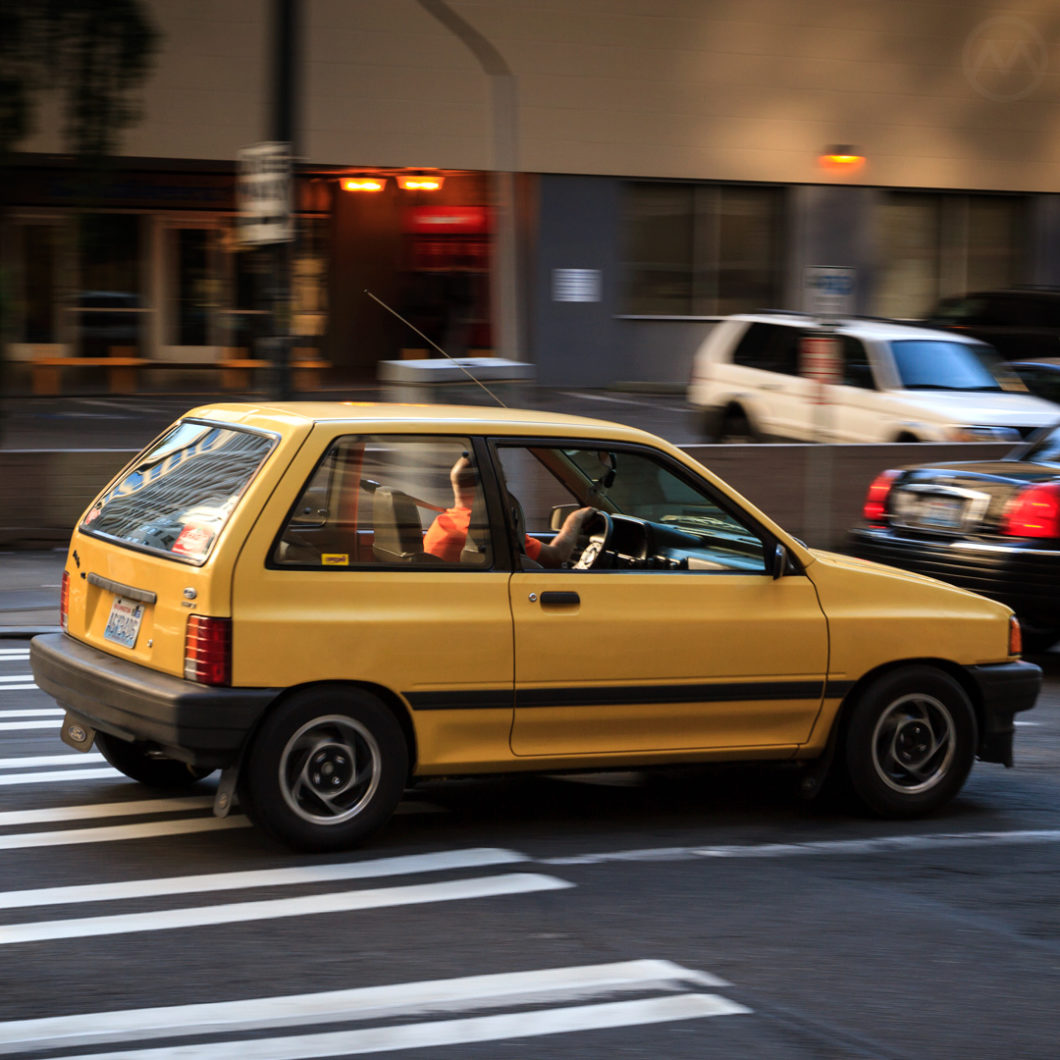As is often the case with the cheapest new cars, nobody expected very much of the Ford Festiva. When new, it was a bottom-feeder. It was a cut above similarly cheap cars like the Hyundai Excel or Yugo GV, maybe, but a slow, nerdy, and bare-bones economy machine nonetheless. Three decades after U.S. Festiva sales ended, however, the car has a big cult following in America.
It proved a surprisingly durable machine for something cheap and cheaply made, and as the old saying goes, it can be a good deal more fun to drive a slow car fast than a fast car slow. The Festiva’s character is defined by its light, go-kart-like feel. It’s not a Peugeot 205 GTI, but in the USA there never were any 205 GTIs to compare it to, and as a very cheap used car it was easy to make even faster.
Developed in the early 1980s by Mazda at Ford’s behest, the Festiva was an international cocktail. Mazda was behind the engineering, but the car was primarily sold as a Ford, even in Japan, while North American market versions were built by Kia Motors in South Korea.
Long after the Festiva was no longer on American’s radar, the model went on to have a long life in international markets. The basic design is still in production in Iran.
The International House of Fords
The story of the Festiva begins with Ford’s ever-increasing stake in Mazda in the 1970s both Mazda and Ford’s partnerships with Kia in that decade.
Ford’s first link with Mazda happened in 1969, when it partnered with Mazda and Nissan to form JATCO (aka the Japanese Automatic Transmission COmpany). JATCO still exists, and makes many of the Continuously Variable Transmissions found in Nissans, among other makes.
From there Ford hoped to acquire a stake in Mazda in 1971 in hopes of staying even with GM’s Rotary-engine development by buying into Mazda’s know-how, but Mazda wasn’t willing to share that technology. It was, however, willing to sell Ford small pickups, which it then sold in the USA as the Ford Courier.
When Mazda’s high-flying Rotary-powered cars came crashing down to earth in the wake of OPEC and a sea of warranty claims, Toyo Kogyo was left in deep crisis, and in 1978 negotiations began again with Ford. First Ford bought 12.9% of Mazda’s stock from Sumitomo Bank, and then upped its stake to 24.4% in 1979.
Ford leaned heavily on Mazda for international products fairly often in the 1980s, but at first those products were for Australia/NZ and Japan, including vehicles like the Ford Spectron Van (a rebadged Mazda Bongo) replaced older European-sourced products like the Transit Mk2.
Meanwhile, Kia had been a Mazda partner since 1974, building licensed Bongo trucks and versions of the small Familia, sold in the USA as the Mazda R100 and in Korea as the Kia Brisa. That was, until the military junta led by dictator Chun Doo-hwan forced industrial changes in the country and prohibited Kia from making cars in 1981.

Eventually, the error of that decision became obvious when both GM and Ford began investigating large-scale production in South Korea. GM’s relationship was with Daewoo and its predecessor company, Saehan. Mazda’s preexisting relationship with Kia was Ford’s entree into manufacturing in South Korea.
In the U.S. market Ford had cancelled its 1970s captive imports, namely the Euro-sourced Fiesta and Mazda-built Courier, in favor of home-grown larger domestic products (the U.S. Escort and the Ranger). But when newer, smaller, and cheaper cars arrived in the USA in the mid-1980s, Ford turned to Mazda to help respond just as it had in Australia.
There were two major Mazda/Small-Ford projects going on in the early 1980s, both involving moving production somewhere cost effective.
The first was the Mazda-sourced car was to the Mercury Tracer, a reworked Mazda 323/Familia that replaced Mercury’s slow-selling Lynx (and led to the U.S. Escort eventually migrating to a Mazda platform). That car was built at a new facility in Hermosillo, Mexico.
The second was the Festiva–a global Ford but one intended to do battle with the smallest and cheapest cars in the U.S.–Hyundai’s Excel, the Yugo, Subaru’s subcompact Justy, and especially the Suzuki-built Chevrolet Sprint.
Autorama in Japan
Mazda designed the car at Ford’s request beginning around 1981, and produced a wide-ish, tall car weighing just over 1,700 lbs. Power came from Mazda’s own SOHC B-engine. In many markets, it came as a 1.1 or as a 1.3-liter with an eight-valve head, though Japanese-market Festivas eventually got a 16-valve head. At first, the Japanese cars came only as a 5-speeder.
The car was directly targeted at the excellent Mk1 Honda City, a vehicle Honda had considered for import to the USA but ultimately rejected. Using the City as a benchmark, it was no surprise that Mazda’s design was tall and small, with lots of interior room for its footprint but a boxy look.
Mazda built Japan’s Ford Festivas in Hiroshima, which were then sold by a company called Autorama. With the goal of conquering Japan just as Japanese brands had conquered the United States, Ford had set up Autorama in concert with Mazda around the time the Festiva project began. It was a joint dealer network and was eventually expanded in 1986 for the purpose of selling more international and U.S.-market Fords in Japan.

Japan actually did have an appetite for American cars, but very few were of a practical size in Japan. Aside from specialty models, they were not very popular even if they were heavily advertised. One of the few popular U.S.-domestic Fords to reach Japan was the 1979-81 Mercury Capri, though many other models were offered at various times.
The Festiva was properly sized for Japan, and very space-efficient, so it did far better than the international-market offerings. Even so, Autorama never really took off, and in the early 1990s the JDM-Festiva was selling about 20-25,000 units annually in Japan.
The Japan-built cars were exported to other markets as the Mazda 121, but not to North America. As Autorama was meant to sell Fords and build the Ford brand, Mazda did not sell the 121 in the home market. Festivas for the U.S. and Canada (and later, other countries) came from Gwangmyeong, South Korea.
Building the Ford Festiva in South Korea
Once investors came calling, the Chun regime allowed Kia to go back to building cars.
Ford was willing to foot the bill for retooling Kia’s original Sohari plant at great expense, and in return it got a 9% stake in Kia. The Chun regime was hoping Ford’s investment would stimulate jobs, in hopes of quieting large scale public discontent; anger that would ultimately bring down the regime in 1988.
The Sohari facility at Gwangmyeong had originally made trucks, with the Brisa sedans a sideline. Today, this plant makes vehicles including the Carnival, Rio, and Stinger, and it was Ford’s investment that made truly large-scale production there feasible, though it has since been expanded again multiple times.
As with the Hermosillo deal, Ford had found that building low-margin small cars in the USA made them price uncompetitive with builders like Hyundai or Suzuki, who simply had lower costs of operation. Encouraged by the free-trading Reagan administration, the Mexico deal was one way to build a car cheaper. Another was to go to South Korea.

But even with the lower costs of labor in South Korea, it was still a huge investment, and Ford got lucky that Kia was a very willing partner looking to learn. Daewoo was not a cooperative partner for GM, and the result was a very low quality product. Even with the cheap labor, the Festiva was priced slightly higher than an equivalent Hyundai Excel or Chevy Sprint.
The Festiva arrived in late 1987, about a year and a half after production began in Korea, only as a manual-only, carbureted 1.3L econobox, a 3-speed Automatic (which American consumers preferred) was added 18 months later along with optional fuel injection. In the first couple of months, sales were confined to California, while the car had gone on sale in the spring of 1987 in Canada.
Just 140.5” (356 cm) long, it was 63” (160cm) wide and rode on skinny 12” tires (many Festivas later got more substantial rubber). With tall, bluff sides and a sort of high-top sneaker profile, the Festiva looked every inch an economy car and had the image to match.
That the car was slightly more expensive than rival bottom-feeders did not necessarily hurt sales, as Ford was seen as a more familiar and reliable brand than Hyundai or Yugo and the experience of offering the Mk1 Fiesta in the USA from 1976 to 1980 meant some familiarity even if the Festiva was a completely different car.
The cars came really stripped (L) or with a few luxuries (LX) and had minor styling differences from market to market–the U.S. never got the slick fabric-topped version offered on Japanese made cars (essentially a giant rollback sunroof), but it did get a wide array of bright colors and, sometimes, jaunty graphics packages of the variety prized today by Vaporwave fans.
The Surprise Hero
The Festiva had all the ingredients needed to be a tiny and fuel-efficient runabout. Manual versions could return upwards of 40 mpg on the highway, though the importance of fuel economy had waned in the 1980s as gas prices fell. That changed in 1990, when the first Gulf War saw fuel prices skyrocket, followed by a recession.
But fuel economy was only part of the appeal. Once buyers settled down with a Festiva, they found that its light weight meant no power steering was necessary and the 1.3-liter four, particularly in fuel-injected form, provided fairly good power so long as the A/C was turned off. It handled quite well for a car whose mission was MPG, not handling prowess or performance. No doubt that had to do with the wheels being pushed out to the very edges of the design.
Light and balanced, the Festiva was not fast, but it was easy to push to its limits and fun to do so, even if that wasn’t the original goal.
Despite stateside misgivings about Korean quality from Hyundai and GM’s Daewoo-sourced Pontiacs, the Festiva proved a very robust vehicle. Many are still on the road in places where they haven’t rusted, and the mechanical pieces were simple and durable.

In the meantime, Kia launched into international markets with its own version of the car, the Kia Pride, starting with Western Europe. In the USA, it could not sell that vehicle due to Ford’s restrictions, and surprisingly, when Kia launched their own cars in the U.S. in 1994, they weren’t quite as well made as the Festiva/Pride. Without Ford’s name, setting up shop was a hard go for Kia on its own.
The best selling Kia in the USA at the time was the Festiva’s replacement, the Kia-built Ford Aspire. Essentially a heavy rework of the original Festiva/121, the Aspire seemed to have far less charm than the Festiva, and never did as well. More than 350,000 Festivas were sold in the USA from 1987-1993, but that was not the end of the story.
The Kia Pride continued for a long time in international markets, being built by Kia itself into 2000, by which time the late 1990s Asian financial crisis had caused Ford to sell off its stake, and drawn Kia and Hyundai together. International licensees, however, kept building the basic design for many years.
SAIPA of Iran began building a licensed Pride in 1993 and continues to make the car today in much-modified form. There were also other body styles from Kia, including four-door sedans and five-door hatches, some of which were shared with Mazda and sold through Autorama in the early 1990s.



I’ve been driving Festivas for over twenty years! Can’t leave well enough alone though… my current one is powered by a Mazda 323GT turbocharged 1.6 liter 16 valve DOHC engine!!!
“jaunty graphics packages of the variety prized today by Vaporwave fans”
I chuckled at this for a solid few paragraphs. As someone who did live through the ’80s and ’90s, I’m mystified by the odd false-nostalgia for their worst tropes among people who didn’t.
Memories memories….
Never had a Festival but owned a ’79 Fiesta Sport.
OEM sunroof and AC, drove and handled like a go cart.
FIRM suspension….I could feel the paint stripes on the road.
BEST BUCKET SEATS EVER!
Have not found their like ever since….
Also had an ’86 Chevy Sprint 5 door with 5 speed shifter, so austere it was fascinating.
I miss reliable vehicles.
😞
in 2023 i am still running my 1992 ford festiva never had any problem with that car and she is 207000 km run like new and no rust at all
I have a device from Saipa Iran with a 1.3-liter 8-valve injector engine produced in Iran with 250,000 kilometers of operation. I am satisfied with driving it.
I loved my 1989 Festiva and drove it for more than 25 years after buying it new. It saw more than 25 New Hampshire winters and racked up 350,000 miles. I would buy another one in a heart beat if I could find one near by in good shape.